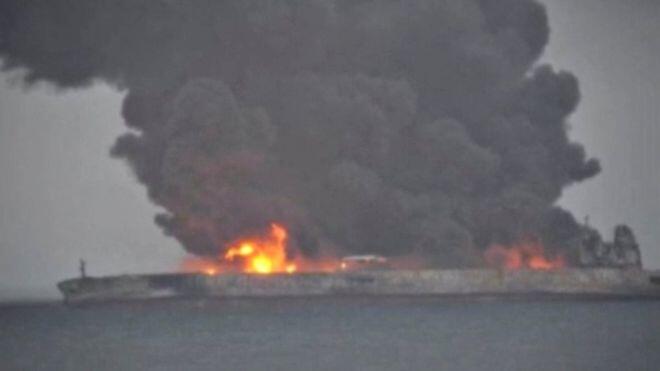There are fears of an environmental disaster in the East China Sea as a tanker continues to leak oil two days after colliding with a cargo ship.
Chinese officials have told state media the Sanchi is in danger of exploding and sinking.
Rescuers attempting to reach the site were being beaten back by toxic clouds, the transportation ministry has said.
The crew, 30 Iranians and two Bangladeshis, remain missing despite international rescue efforts.
Where, how and when did the accident happen?
The Panama-flagged Sanchi was bringing its cargo of oil from Iran to South Korea when it was in collision with the Hong Kong-registered freighter CF Crystal, carrying grain from the US, in the East China Sea, about 260km (160 miles) off the coast of Shanghai.
The collision, in the mouth of the Yangtze River Delta, occurred on Saturday evening.
The exact cause of the collision is not yet known.
What exactly is the Sanchi carrying?
The tanker, run by Iran’s leading oil shipping operator, has on board 136,000 tonnes of condensate, which is an ultra light version of crude oil.
That’s about one million barrels and at current prices is worth roughly $60m (£44m).
The Sanchi will also be carrying a certain amount of heavy – and toxic – shipping fuel.
Condensate is very different from the black crude that is often seen in oil spills.
It exists in gas form within high-pressure oil reservoirs and liquefies once extracted.
It is highly toxic, low in density and considerably more explosive than regular crude oil.
So is it bad for the environment?
It is potentially worse than heavy crude.
Condensate remains liquid only under certain conditions.
John Driscoll of JTD Energy Services told the BBC: “Condensate is more likely to evaporate or mix in with the water.
“It also can be colour- and odour-less, so it is a lot harder to detect, contain and clean up.”
The environmental impact of the spill may be mitigated by the distance of the collision from the nearest coastline.
How is the rescue going?
The Sanchi was still ablaze on Monday morning.
There is no word on the fate of the 32-strong crew, although the 21 Chinese nationals on the grain freighter were rescued.
China has sent several ships to carry out search-and-rescue operations, while South Korea helped with a coast guard ship and a helicopter.
The US Navy also sent a military aircraft to help with the rescue efforts.
Source: http://bbc.in/2CCjPp7











